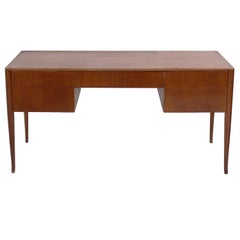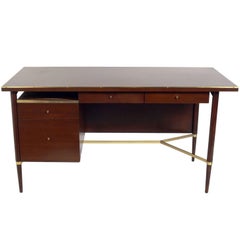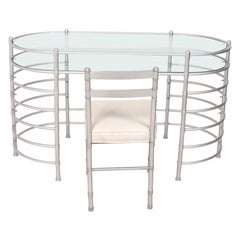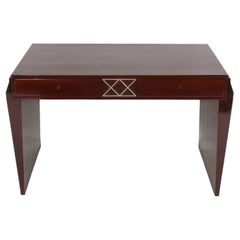Want more images or videos?
Request additional images or videos from the seller
1 of 8
Art Deco Desk by Wolfgang Hoffmann for Howell
$2,500List Price
About the Item
- Creator:Wolfgang Hoffmann (Designer)
- Dimensions:Height: 30 in (76.2 cm)Width: 44 in (111.76 cm)Depth: 24 in (60.96 cm)
- Materials and Techniques:
- Place of Origin:
- Period:
- Date of Manufacture:1930's
- Condition:Wear consistent with age and use. Very good condition. Refinished in black color lacquer. Some wear to top. Newly chrome plated legs and hardware. Minor surface scratches and wear.
- Seller Location:Atlanta, GA
- Reference Number:1stDibs: U12111287181282
About the Seller
4.7
Vetted Professional Seller
Every seller passes strict standards for authenticity and reliability
Established in 1996
1stDibs seller since 2009
2,421 sales on 1stDibs
Typical response time: 3 hours
Authenticity Guarantee
In the unlikely event there’s an issue with an item’s authenticity, contact us within 1 year for a full refund. DetailsMoney-Back Guarantee
If your item is not as described, is damaged in transit, or does not arrive, contact us within 7 days for a full refund. Details24-Hour Cancellation
You have a 24-hour grace period in which to reconsider your purchase, with no questions asked.Vetted Professional Sellers
Our world-class sellers must adhere to strict standards for service and quality, maintaining the integrity of our listings.Price-Match Guarantee
If you find that a seller listed the same item for a lower price elsewhere, we’ll match it.Trusted Global Delivery
Our best-in-class carrier network provides specialized shipping options worldwide, including custom delivery.You May Also Like
Deco Bauhaus chrome 3 drawer desk by Wolfgang Hoffmann Desk for Howell
By Wolfgang Hoffmann, Howell
Located in Brooklyn, NY
Deco Bauhaus chrome 3 drawer desk by Wolfgang Hoffmann Desk for Howell. Bent chrome tube structure with 3 drawers. Good vintage condition for its age shows wear and use to chrome and...
Category
Vintage 1930s American Bauhaus Desks
Materials
Chrome
$2,880 Sale Price
20% Off
H 31 in W 44 in D 25 in
Vintage Modern Writing Desk by Wolfgang Hoffman
By Wolfgang Hoffmann
Located in Brooklyn, NY
This stylish black lacquer writing desk features the unique vintage design of Mid-Century Modern designer Wolfgang Hoffman. Spacious drawers with tubu...
Category
Vintage 1940s American Art Deco Desks
Materials
Metal
Art Deco Signed Wolfgang Hoffmann for Romweber World's Fair Display Cabinet
By Wolfgang Hoffmann, Romweber Furniture Co.
Located in Forney, TX
A rare and important Art Deco period Century of Progress Display Cabinet designed by Wolfgang Hoffmann (Austrian, 1900-1969) for Romweber Company, Batesville, Indiana, United States of America. circa 1933-1936
Created for the 1933 Chicago World's Fair, one piece design, having a rectangular showcase top with glass panel sides and a pair of sliding glass doors, over solid wood chest fitted with four drawers affixed with horizontal pulls, flanked by cabinet doors, opening to shelved interior. Rosewood, mahogany, richly figured blonde - golden birch or primavera, and glass.
Signed, original label to drawer interior, featuring 1933 World's Fair mark impressed.
**Please note, at the time of writing this, a matching sideboard - buffet (shown in last photo) is currently available separately**
Provenance / Acquisition:
Property from the important and iconic collection of Mr. James I. Rafftesaeth Jr., Dallas, Texas
Acquired from highly reputable auction house, Heritage Auctions, Dallas, Texas. 2022 Design Signature Auction catalog #8091
History:
Wolfgang Hoffmann was born in Vienna, Austria in 1900. He is the son of famous architect, pedagogue and Wiener Werkstatte cofounder, Joseph Hoffmann (1870-1956). Early on, following his father’s s interests, he was trained in the decorative arts and design. Wolfgang Hoffmann once reminisced, “I spent eight years at the Realschule, then three years went to a special architectural school, where I perfected my technical knowledge of architecture and general construction. From this school, I was graduated to the Kunstgewerbeschule [Studying under Oskar Strnad and Josef Frank in Vienna]. After finishing this school, I had one and a half years of practical in a well known architect’s office. Thereafter I worked in my Father’s office for two years”.
Hoffmann met his future wife, Polish immigrant Pola (1902-1984) when they were both studying at the Kunstgewerbeschule. Joseph Urban (1872-1933) was needing an assistant for his architectural business in New York and contacted his friend and colleague, Joseph Hoffmann in Vienna. Hoffmann recommended his son Wolfgang. Urban hired him and sent a first class passage ticket to Vienna for Wolfgang to travel to New York. Wolfgang married Pola and traded his ticket for two tickets to America in steerage, arriving in New York City in December of 1925.
Leaving the Urban office after nine months, Wolfgang and Pola formed an independent design practice with offices on Madison Avenue in Manhattan with the purpose of creating contemporary interiors and industrial designs. Early work included theaters, stores, and apartments mostly in New York City.
During the late 1920’s and early 1930’s the Hoffmanns designed custom furniture for private clients. Some of these examples were shown in the February 1929 issue of House and Garden. Curiously, the examples’ design was attributed to Urban and the production to Pola Hoffmann, Inc.
Established in the fall of 1928, the American Designers’ Gallery was “devoted exclusively to showing objects and interiors for practical use… by fourteen American architects and designers”. Its members included the Hoffmans and Urban as well as ceramist Henry Varnum Poor (1888-1971), architect Raymond Hood (1881-1934), artist designer Winold Reiss (1886-1953), graphic designer Lucien Bernhard (1896-1981), decorator Donald Deskey (1894-1989), and architect Ely Jacques Kahn (1884-1972).
The Hoffmanns’ work was included in the American Designers’ Gallery’s two showcase events, its 1928 and 1929 exhibitions. Their dining alcove at the 1929 event featured a bench with a dinette table and two chairs in American walnut designed by Wolfgang and a rug by Pola.
Lucien Bernhard, fellow Austrian immigrant who settled in New York a year before the Hoffmanns, operated the gallery and decorating service Contempora with Munich resident Bruno Paul (1874-1968). The Hoffmanns, occasionally participating with Contempora, designed a number of outstanding interiors, including the constructivist living room of 1930 for Mrs. O.R. Sommerich at 40 East 66th street. In 1934, Donald Deskey commissioned Wolfgang to design birchwood furnishings for the eclectic apartment at 625 Park Avenue belonging to Helena Rubinstein.
In 1931, Wolfgang exhibited his work at the Pennsylvania Art Museum and the Museum of Modern Art in New York City. The same year, with Kem Weber (1889-1963) he organized the second and final exhibition of AUDAC- “Modern Industrial and Decorative Arts”- at the Brooklyn Museum. At this event, the Hoffmanns showed the dining room previously included in the American Designer’s Gallery’s 1929 exhibition in the Chase Bank Building lobby at 145 West 57th Street in Manhattan.
In 1932 Wolfgang was asked to assist Urban in developing the color scheme for the 1933-34 Chicago World’s Fair “A Century of Progress”. He was also commissioned to design the interior and furniture for the fair’s lumber industries house. There he executed its living and dining rooms furnished by Kroehler Manufacturing Company of Chicago; the boys’ room by Shower Brothers...
Category
Early 20th Century American Art Deco Vitrines
Materials
Glass, Mahogany, Rosewood
$9,500
H 66.75 in W 47.5 in D 19.5 in
Art Deco Wolfgang Hoffmann Romweber World's Fair Century of Progress Sideboard
By Wolfgang Hoffmann, Romweber Furniture Co.
Located in Forney, TX
A rare and important American Art Deco Century of Progress Sideboard by iconic designer Wolfgang Hoffmann (Austrian, 1900-1969) for Romweber Company, Batesville, Indiana. circa 1933-1936
Created for the 1933 Chicago World's Fair, fine quality craftsmanship and construction, having a rectangular exotic rosewood veneered top over conforming solid wood case fitted with four drawers affixed with horizontal pulls, the top drawer opening to reveal felt lined divided interior for silverware, flanked by cabinet doors opening to shelved interior, subtle geometric lines add interest. Rosewood, mahogany, richly figured blonde - golden birch or primavera.
Signed, top drawer interior, featuring 1933 World's Fair mark impressed.
**Please note, at the time of writing this, a matching display case - vitrine cabinet (shown in last photo) is currently available separately**
Provenance / Acquisition:
Property from the important and iconic Collection of Mr. James I. Rafftesaeth Jr., Dallas, Texas
Acquired from highly reputable auction house, Heritage Auctions, Dallas, Texas. 2022 Design Signature Auction catalog #8091
History:
Wolfgang Hoffmann was born in Vienna, Austria in 1900. He is the son of famous architect, pedagogue and Wiener Werkstatte cofounder, Joseph Hoffmann (1870-1956). Early on, following his father’s s interests, he was trained in the decorative arts and design. Wolfgang Hoffmann once reminisced, “I spent eight years at the Realschule, then three years went to a special architectural school, where I perfected my technical knowledge of architecture and general construction. From this school, I was graduated to the Kunstgewerbeschule [Studying under Oskar Strnad and Josef Frank in Vienna]. After finishing this school, I had one and a half years of practical in a well known architect’s office. Thereafter I worked in my Father’s office for two years”.
Hoffmann met his future wife, Polish immigrant Pola (1902-1984) when they were both studying at the Kunstgewerbeschule. Joseph Urban (1872-1933) was needing an assistant for his architectural business in New York and contacted his friend and colleague, Joseph Hoffmann in Vienna. Hoffmann recommended his son Wolfgang. Urban hired him and sent a first class passage ticket to Vienna for Wolfgang to travel to New York. Wolfgang married Pola and traded his ticket for two tickets to America in steerage, arriving in New York City in December of 1925.
Leaving the Urban office after nine months, Wolfgang and Pola formed an independent design practice with offices on Madison Avenue in Manhattan with the purpose of creating contemporary interiors and industrial designs. Early work included theaters, stores, and apartments mostly in New York City.
During the late 1920’s and early 1930’s the Hoffmanns designed custom furniture for private clients. Some of these examples were shown in the February 1929 issue of House and Garden. Curiously, the examples’ design was attributed to Urban and the production to Pola Hoffmann, Inc.
Established in the fall of 1928, the American Designers’ Gallery was “devoted exclusively to showing objects and interiors for practical use… by fourteen American architects and designers”. Its members included the Hoffmans and Urban as well as ceramist Henry Varnum Poor (1888-1971), architect Raymond Hood (1881-1934), artist designer Winold Reiss (1886-1953), graphic designer Lucien Bernhard (1896-1981), decorator Donald Deskey (1894-1989), and architect Ely Jacques Kahn (1884-1972).
The Hoffmanns’ work was included in the American Designers’ Gallery’s two showcase events, its 1928 and 1929 exhibitions. Their dining alcove at the 1929 event featured a bench with a dinette table and two chairs in American walnut designed by Wolfgang and a rug by Pola.
Lucien Bernhard, fellow Austrian immigrant who settled in New York a year before the Hoffmanns, operated the gallery and decorating service Contempora with Munich resident Bruno Paul (1874-1968). The Hoffmanns, occasionally participating with Contempora, designed a number of outstanding interiors, including the constructivist living room of 1930 for Mrs. O.R. Sommerich at 40 East 66th street. In 1934, Donald Deskey commissioned Wolfgang to design birchwood furnishings for the eclectic apartment at 625 Park Avenue belonging to Helena Rubinstein.
In 1931, Wolfgang exhibited his work at the Pennsylvania Art Museum and the Museum of Modern Art in New York City. The same year, with Kem Weber (1889-1963) he organized the second and final exhibition of AUDAC- “Modern Industrial and Decorative Arts”- at the Brooklyn Museum. At this event, the Hoffmanns showed the dining room previously included in the American Designer’s Gallery’s 1929 exhibition in the Chase Bank Building lobby at 145 West 57th Street in Manhattan.
In 1932 Wolfgang was asked to assist Urban in developing the color scheme for the 1933-34 Chicago World’s Fair “A Century of Progress”. He was also commissioned to design the interior and furniture for the fair’s lumber industries house. There he executed its living and dining rooms furnished by Kroehler Manufacturing Company of Chicago; the boys’ room by Shower Brothers...
Category
Early 20th Century American Art Deco Sideboards
Materials
Birch, Mahogany, Rosewood
$9,500
H 30 in W 49 in D 20 in
Art Deco Desk by Ernest Boiceau
By Ernest Boiceau
Located in New York, NY
This Boiceau desk bears his stamp, and was entirely veneered in amboyna, an exotic burlwood named for Ambon, the Indonesian island where it was harvested. The naturally squiggling patterning of the veneer provides an overall surface decoration. The top alone has no fewer than 60 small book-matched squares of it – ten across and six deep – creating a kaleidoscopic effect in subtle monochrome. Applied decoration is minimal. It consists of two inlaid pairs of griffins in boxwood and purplewood facing off across braziers on both the front and the back of the desk, and blind-tooled Greek keys trimming white-leather-topped shelves that slide out to either side. These decorations introduce no color, and, in lying flush with the surface, leave the sleek form undisturbed. Boiceau even eliminated drawer pulls, necessitating a lock and key for each drawer.
Born in Lausanne in 1881, Boiceau descended from French Huguenots who had settled in Switzerland. Prominent as bankers, lawyers, businessmen, and diplomats, the Boiceaus were a cosmopolitan family. Ernest studied painting in Munich, and then painting and architecture in Paris at the École des Beaux-Arts. In 1900 he embarked on a ten-year European sojourn, painting landscapes and portraits along the way. In 1910 he resettled in Paris, became interested in textiles, and established an embroidery workshop that catered to the stage and haute couture. Among his clients were the Folies Bergères, the Comédie-Française, and the Paris Opéra, and the fashion houses of Worth and Molyneux. He also made embroidered table linens, wall hangings, and upholstery fabrics. In a 1913, at an embroidery exhibition in Paris at the Musée Galliera, he presented a boudoir in collaboration with curtains, upholstery fabrics, and a tapestry, embroidered in modern abstract designs. In 1925 he launched a couture line, and branched out to design finely crafted objects and furniture made in rare woods, like ebony and Tasmanian oak...
Category
Vintage 1920s French Art Deco Desks
Materials
Bronze, Other
Art Deco Desk by NORDISKA KOMPANIET
By NK (Nordiska Kompaniet)
Located in Ciudad Autónoma Buenos Aires, C
Art Deco desk, made of maple veneered wood with inlays, keyholes and ivory strips. By NORDISKA KOMPANIET S:A (1920-1970). Signed by NORDISKA KOMPANIET S,A., BS AIRES, Florida 101.
A...
Category
Vintage 1930s Argentine Art Deco Desks
Materials
Maple
Art Deco Style Desk
Located in Westwood, NJ
Art Deco style desk elegantly styled with golden amber burr veneer and three drawers with subtle stringing inlay. Raised on four tapering sabre leg...
Category
21st Century and Contemporary Vietnamese Modern Desks and Writing Tables
Materials
Wood
Small Art Deco Desk
Located in New York, NY
An Art Deco small desk. Amboyna with inlaid details,
red bakelite and brass pulls. Desk features four drawers
a storage cabinet and an additional storage area underneath a lift u...
Category
Vintage 1930s Italian Art Deco Desks
Materials
Brass
Deco Birch Desk by Saarinen for Johnson, 1940's
By Eliel Saarinen, Johnson Furniture Company
Located in Phoenix, AZ
Eliel Saarinen for Johnson desk circa 1948. This rare example executed in birch has three drawers, sculptural s shaped legs and formed aluminum pulls. It has been masterfully restore...
Category
Vintage 1940s North American Mid-Century Modern Desks
Materials
Aluminum
Art Deco Machine Age Industrial Desks by Bel Geddes for Simmons Furniture Co.
By Simmons Company Furniture, Norman Bel Geddes
Located in New York, NY
High Style, Art Deco, Machine Age, Industrial design desk(s) by Norman Bel Geddes for Simmons Furniture Company circa 1930's. The desks feature a bank of three drawers which flank th...
Category
Vintage 1930s American Art Deco Desks
Materials
Steel
$495
H 30 in W 60 in D 21 in
More From This Seller
View AllCurvaceous Desk by T.H. Robsjohn Gibbings
By T.H. Robsjohn-Gibbings, Widdicomb Furniture Co.
Located in Atlanta, GA
Curvaceous desk, designed by T.H. Robsjohn-Gibbings for Widdicomb, American, circa 1950s. This desk is currently being refinished and can be completed in your choice of finish color.
Category
Vintage 1950s American Mid-Century Modern Desks and Writing Tables
Materials
Walnut
Clean Lined Modern Desk by Paul McCobb
By Paul McCobb
Located in Atlanta, GA
Clean lined modern desk, designed by Paul McCobb, American, circa 1960s. This desk is currently being refinished and can be completed in your choice of finish color. The price noted ...
Category
Vintage 1950s American Mid-Century Modern Desks and Writing Tables
Materials
Brass
Warren McArthur Art Deco Desk and Chair
By Warren McArthur
Located in Atlanta, GA
Art Deco aluminum desk and chair designed by Warren McArthur, American, circa 1930s. The chair measures 31"H x 15.75"W x 17"D x 18" seat height.
Category
Vintage 1930s American Art Deco Desks and Writing Tables
Materials
Aluminum
$5,750 / set
Elegant French Art Deco Desk circa 1930s
Located in Atlanta, GA
Elegant French Art Deco Desk, France, circa 1930s. Stylish tapered leg form with geometric inlaid design between the drawers. Two deep locking drawers provide ample storage and it re...
Category
Vintage 1930s French Art Deco Desks and Writing Tables
Materials
Metal
Pair of Rare Art Deco Credenzas by Russel Wright for Heywood Wakefield
By Russel Wright
Located in Atlanta, GA
Pair of rare Art Deco Credenzas, designed by Russel Wright for Heywood Wakefield, American, circa 1930s. Each chest measures 36"H x 48"W x 15"D. The extended serving table top measur...
Category
Vintage 1930s American Art Deco Commodes and Chests of Drawers
Materials
Chrome, Metal
Collection of Knickerbocker Art Deco Cocktail Glasses by Edwin Fuerst for Libbey
By Libbey Glass Co., Edwin W. Fuerst
Located in Atlanta, GA
Collection of Nineteen "Knickerbocker" Pattern Art Deco Cocktail Glasses, designed by Edwin Fuerst for The Libbey Glass Company, American, circa 1930s. Th...
Category
Vintage 1930s American Art Deco Tableware
Materials
Glass



